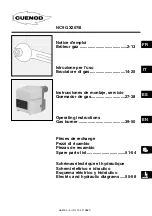
11
420010331900
Maior P 150.1/200.1 AB
EN
1 - INLET
2 - RETURN
3 - BLEED AND PRESSURE GAUGE PORT
4 - VACUUM GAUGE PORT
VERIFY:
- That piping system is perfectly sealed;
- That the use of hoses is avoided whenever is possible (use copper pipes preferably);
- That depression is not greater than 0,45 bar, to avoid pump’s cavitation;
- That check valve is suitably designed for the duty;
The pump pressure is set at a value of 12 bar during the testing of burners. Before starting the burner, bleed
the air in the pump through the gauge port. Fill the piping with light-oil to facilitate the pump priming.
Start the burner and check the pump feeding pressure. In case the pump priming does not take place during
the first prepurging, with a consequent, subsequent lock-out of the burner, rearm the burner’s lock-out to
restart, by pushing the button on the control box. If, after a successful pump priming, the burner locks-out
after the prepurging, due to a fuel pressure drop in the pump, rearm the burner’s lock-out to restart the bur-
ner. Do never allow the pump working without oil for more than three minutes. Note: before starting the
burner, check that the return pipe is open. An eventual obstruction could damage the pump sealing device.
5 - PRESSURE ADJUSTMENT
6 - TO NOZZLE
BURNER START-UP AND ADJUSTMENT
Once having installed the burner, check the following items:
- The burner power feeding and the main line protection fuses
- The correct length of pipes and that the same are sealed.
- The type of fuel, which must be suitable for burner.
- The connection of boiler’s thermostats and all the safeties.
- The motor rotation direction.
- The correct calibration of the motor’s thermal protection.
When all the above mentioned conditions are checked and accomplished, it is possible to go on with burner’s
tests. Power the burner. The control box feeds the ignition transformer and the burner’s motor at the same
time, which will run a prepurging of the combustion chamber for about 20 sec.
At the end of prepurging, the control box opens the fuel pump and the 1st stage (Low flame) solenoid valves,
the ignition transformer produces a spark and the burner ignites. After a safety interval of 5 seconds and a
correct ignition, the control box turns off the ignition transformer and, 10 seconds later, sets the motorised
air damper to its maximum opening and opens the 2nd stage solenoid valve (High flame). In case of faulty
ignition, the control box switches the burner into safety condition. In such a case, the manual rearming of the
burner shall not take place before 30 seconds have elapsed from the burner’s safety shutdown. In order to
obtain an optimal combustion, it is necessary adjust the LOW - HIGH flame air flow, according to the
instruction given further on. During such a phase, it will be possible to manually switch between HIGH ( II )
and LOW ( I ) flame and viceversa, through the High/Low flame switch. At the end of the adjusting phase,
leave the switch in position II (HIGH flame).
The fuel pump feeding pressure, must remain around 12 bar.
I
II
I - 1st Stage.
II - 2nd Stage (with an eventual Low/High automatic switching through a further
thermostat connected to the terminal board, as shown by the scheme).











































